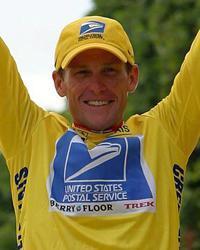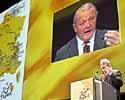
Recently on Cyclingnews.com |
91st Tour de France - July 3-25, 2004
Tour '04: Can Armstrong form a league of his own?
By Cyclingnews staff
 |
(Paris, France - October 23, 2003): Today in Paris at the Palais des Congres, the route of the 2004 Tour de France was officially unveiled to the public. As the road season in Europe draws to a close, the announcement comes as one of the most eagerly-anticipated events in the year as teams, managers and riders finalise their rosters and begin their plans for those crucial three weeks in July.
Like the Centenary Tour of 2003, the 91st edition of the world's largest annual sporting event may be just as historic, although for different reasons. Hailing from Austin, Texas, Lance Armstrong, now 32 years of age, will be the man aiming to rewrite the history books as he endeavours to take an unprecedented sixth Tour de France victory.
The 3391 kilometre route will follow the non-traditional anticlockwise direction, considered on paper to be the more difficult of the two routes. In the last decade of the Tour, it has been a direction followed five times - two of those being Armstrong's second (2000) and fourth victories (2002) - both of which he won with apparent ease.
On Saturday, July 3, the 2004 Tour kicks off for the first time from the industrial city of Liège, the start/finish town of Belgium's climbers' classic and World Cup race, Liège-Bastogne-Liège. The six kilometre prologue should provide an excellent indication of form for those aiming high on the general classification, with the overall winner often found amongst the top 10 placegetters.
 |
Belgium remains the battleground for the following three stages, with Stage 3 beginning in Waterloo, a historic battleground in itself. Fought thirteen kilometres south of Brussels, The Battle of Waterloo was the scene where the French, under the command of Napoleon Bonaparte, were defeated by the Allied armies commanded by the Duke of Wellington from Britain and General Blücher from Prussia, marking an end to 23 years of war.
Le Tour then heads west back into France and due south, where a typical succession of flat stages plays perfectly into the hands of sprinters including the Aussie duo of Baden Cooke (last year's maillot vert) and Robbie McEwen (points winner in 2002), always consistent Erik Zabel and Alessandro Petacchi, who, by the nature of his success this season, has dethroned the Lion King of old, Mario Cipollini.
After Stage 8, the riders are transferred by plane to their first rest day in Limoges in the province of Limousin, vividly remembered as the place of Armstrong's emotional stage win in honour of fallen team-mate Fabio Casartelli, who tragically died from head injuries sustained from a crash in the '95 Tour. Continuing towards the Pyrénées, the peloton winds its way through the provincial towns of Gueret (Stage 9), St Flour (Stage 10) and the mediaeval town of Figeac (Stage 11), nestled on the banks of the river Célé.
Two critical Pyrénéean stages follow. Featuring back-to-back mountain-top finishes, these two days will certainly provide the first serious reordering on general classification, and quite possibly the ultimate winner of the 2004 Tour. Stage 12 from Castelsarrasin ends high above in the ski town of La Mongie; however what follows will be the queen stage the 2004 Tour - the Stage 13 from Saint Gaudens/Lannemezan to Plateau de Beille, featuring a mouth-watering five mountain passes and an incredible 80.5 kilometres of climbing in 217 kilometres. One may remember the last time the Tour finished atop the Plateau de Beille two years ago in the 2002 TdF, where Armstrong crushed his rivals and any hopes Joseba Beloki may have had of wearing the maillot jaune. An undulating road stage follows on Stage 14 before the riders are greeted with a 24 hours of chill-time at the Tour's second rest day in Nimes.
 |
The Alps provide no respite for what's left of the 189 starters: Stage 15 is a classic Alpine stage, beginning in Valréas and finishing near Grenoble in the town of Villard-de-Lans. Coming very late in the peace is the first individual time trial, and what a TT it is. Fifteen kilometres and almost all uphill, Stage 16 from Bourg d'Oisans to Alpe d'Huez, the scene of so many epic battles in Tours past, is a pearler and in some ways will suit a non-explosive climber like Ullrich than if he were to race up L'Alpe in the company of grimpeurs like Armstrong, Mayo or Beloki. A more orthodox but by no means any easier day follows on Stage 17; the sixth and final Alpine stage, again beginning in Bourg d'Oisans, crosses the Col du Glandon, Madeleine, Tamié, Forclaz and Croix-Fry before the finish in le Grand Bornand.
Stage 18 from Annemasse to Lons le Saunier moves the peloton slowly towards their final destination in Paris - but not before the last of the individual time trials the following day around Besancon. On July 25, the riders will finally be able to celebrate as the Tour hits the French capital, and the world will know if Lance Armstrong has formed a league of his own.
 |
The Route
- Prologue - July 3: Prologue Liege ITT, 6.1 km
- Stage 1 - July 4: Liège-Charleroi, 202.5 km
- Stage 2 - July 5: Charleroi-Namur, 197 km
- Stage 3 - July 6: Waterloo - Wasquehal, 210 km
- Stage 4 - July 7: Cambrai - Arras TTT, 64.5 km
- Stage 5 - July 8: Amiens - Chartres, 200.5 km
- Stage 6 - July 9: Bonneval - Angers, 196 km
- Stage 7 - July 10: Chateaubriant - Saint Brieuc, 204.5 km
- Stage 8 - July 11: Lamballe - Quimper, 168 km
- July 12: Rest Day: Transfer to Limoges
- Stage 9 - July 13: St Leonard de Noblat - Guéret, 160.5 km
- Stage 10 - July 14: Limoges - St Flour, 237 km
- Stage 11 - July 15: St Flour - Figeac, 164 km
- Stage 12 - July 16: Castelsarrasin - La Mongie, 197.5 km
- Stage 13 - July 17: Lannemezan - Plateau de Beille, 205.5 km
- Stage 14 - July 18: Carcassonne - Nimes, 192.5 km
- July 19 - Rest Day: Nimes
- Stage 15 - July 20: Valreas - Villard-de-Lans, 180.5 km
- Stage 16 - July 21: Bourg d'Oisans - Alpe d'Huez ITT, 15.5 km
- Stage 17 - July 22: Bourg d'Oisans - Le Grand Bornand, 204.5 km
- Stage 18 - July 23: Annemasse - Lons le Saunier, 166.5 km
- Stage 19 - July 24: Besancon - Besancon ITT, 55 km
- Stage 20 - July 25: Montreau - Paris-Champs-Elysees, 163 km
